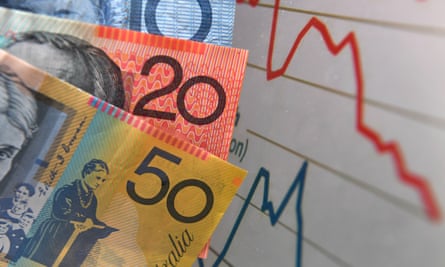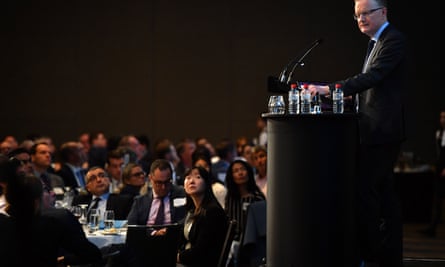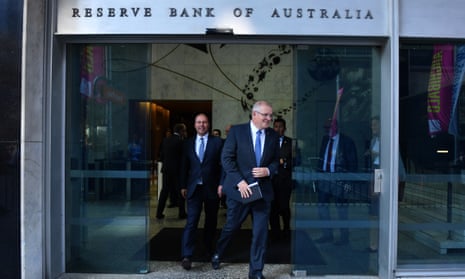Wages are stagnant. Wealth is falling. House prices are down. Consumers aren’t spending. Businesses aren’t investing. Interest rates are at record lows and may be heading for zero. The federal government and Reserve Bank seem locked in an arm wrestle over whether fiscal or monetary policy should be used to generate more stimulus. Unemployment has stopped going down. Overseas, storm clouds are darkening.
Though the last national accounts showed the Australian economy grew by 1.8% in the year to March, things feel worse than that. If the economy is not actually tanking, it is certainly anaemic. Has Australia entered a new, post-growth phase?
A no-growth economy might be welcomed by those who have long objected to the overriding emphasis on gross domestic product as a measure of national success to the exclusion of social or environmental indicators.
Jim Stanford, director of the Australia Institute’s Centre for Future Work says while growth should not be be the goal of economic policy, nor is it the enemy.
“If we actually pursued a zero-growth strategy (as some environmentalists advocate), it would mean the total output of the economy would be stagnant, even as population grows and productivity increases. That would imply falling incomes and material living standards (per capita), growing inequality, and most likely steadily rising unemployment.”

“We’re not in a no-growth economy,” he says. “We’ve experienced very slow growth and that’s a sign of the weakness of Australia’s growth model and the failure of trickle-down policies.”
Australia has managed to avoid recession for a record-breaking 28 years, but this run of good fortune cannot continue indefinitely. One reason the economy feels so flat, notwithstanding official forecasts that growth will gradually tick back up to the respectable long-term average of just under 3%, is that the economy is in “per-capita recession”. The term was hardly used until February, when economist Alex Joiner – looking at some particularly dismal construction data – flagged that the next quarterly growth figures would show Australia’s economy going backwards, once population growth was stripped out.
To be precise, a global Factiva search shows that nine out of 10 occurrences of the term “per-capita recession” have been in Australian media, and more than nine out of 10 have been this year. Nobody else is worried about it – until the financial crisis, the term was never used – and it has crept up on Australians quite suddenly, even as March figures showed the economy had passed three-quarters of per-capita recession.
What’s going on? Joiner, who is chief economist for Industry Funds Management, says no other country talks about per-capita recession because no other advanced economy is experiencing it, and it’s a consequence of Australia’s high rate of overseas migration.
“It’s a double-edged sword for the Australian economy,” he says. “The bald driver of Australia’s economic growth is really population. So when you say we’ve entered a no-growth economy, it’s no growth per capita. We are just simply benefitting, in an economic sense, from the number of people we can attract to come to this country.”
That feeling of economic malaise, despite apparently robust headline figures, is no illusion. The annual Hilda survey of household disposable incomes, released a fortnight ago, showed that Australians’ wealth and living standards had fallen slightly, in real terms, since 2009. Columnists lamented Australia’s “lost decade”.
Melbourne University professor Mark Wooden, director of the Hilda survey, cautions against overdramatising the findings and suggests new arrivals – who typically earn less – drag down the median income figures on which it relies. Australians who lived and worked here the entire decade probably are still ahead.

“I suspect the aggregate picture is overly negative,” says Wooden, adding that in any case “going nowhere is better than going backwards”.
“There is this expectation, based on the past, that we should just get richer and richer and richer. I guess that’s based on some view that about technology driving huge productivity gains, etcetera. Well, it’s not so obvious to me, that that need be the case. We can’t continue to think each generation will be better than the previous one.”
Jim Stanford argues Australia has finally run out of luck. For close to 20 years the twin drivers of the economy have been the mining boom and a debt-fuelled housing boom, and both have predictably run their course. The Australian economy desperately needs to diversify, he says, and will keep on “staggering, until it finds another engine to propel it forward”.
Stanford rejects the official line that wage stagnation is a worldwide trend. “It’s not at all true that everyone is suffering wage stagnation. There are some countries – Germany, Japan, even America – where wages are growing faster than they have in recent history, and many countries where they’re just chugging along at a normal pace.”
Far from entering a new economic paradigm, Stanford argues, Australia has simply failed at the old one. “Australia has experienced the biggest deceleration in wages since 2013, of any major industrial country. So it’s quite wrong to assume what we’re seeing in Australia is a universal phenomenon. The government has implied that, so we don’t blame them for the problem.”
The Centre for Future Work estimates that despite record high levels of workforce participation there are three million Australians who are either unemployed, underemployed or “marginally attached” to the labour force – meaning people who would like to work but are currently not looking for it. If that’s close to the mark, even if the government meets its target of 1.25m new jobs, it may not be enough to boost wages.
While public infrastructure spending has probably staved off a real recession, Stanford says the federal government’s major ploy so far has been to lower business taxes which “really don’t work in terms of stimulating new investment and innovation”.
What’s needed is business investment that will drive productivity improvements in the services sector, value-added manufacturing or high-tech exports. Instead, Stanford says, business simply lobbies for a friendlier environment through tax cuts and red tape removal and labour market deregulation – all trademark trickle-down economics, which has not paid off.

So far, at least, technology has not undercut employment in Australia. Instead of the much-feared jobless growth, Stanford says, the economy has experienced “growthless job creation”. That means new jobs being generated – in hospitality, for example – are dismal in terms of income, security and productivity. Australian companies are not even investing in automation, Stanford says. “The business class has been content to sit back, watch the profits continue to roll in from investments that they’ve already made … but really not get out of bed to do their job,” he says. “It’s funny, with all this conversation about dole bludgers, the group in Australia that’s really been accustomed to getting money without working is the business community. Their profits are at near-record levels, and their investment effort has rarely been weaker. And yet all they can do is demand more government handouts.”
Stanford is not alone in thinking things could get worse. Wooden acknowledges the prospect of a recession is now greater than any time since 2008, and says the economy is “on a knife edge”. The Commonwealth Bank chief economist, Michael Blythe, says the market consensus is that a recession is a one in five chance (based largely on fears about the US-China trade war) though he doesn’t expect one himself. Instead he argues that economic recovery has been so weak because financial crises historically take longer to work through than other busts.
“We do have a large group of people who feel they are going backwards,” Blythe says, citing the well-known “elephant curve” which charts the real increase in income per adult globally and shows rising wealth in developing countries representing the bottom three-quarters of the world population, but no growth at all in the next quarter (the angry working and middle classes of developed countries) excepting a huge spike for the top 1%. Blythe says these charts help explain the populism of Trump and Brexit, and to an extent Australia. Politicians here have responded by making their number one concern the rise in living costs – what Blythe calls the “pain spend”, on power bills and childcare – which makes people on stagnant incomes feel poorer and keeps their wallets shut. But this effort to get prices down puts the government at odds with the Reserve Bank, trying to get inflation back up into its 2-3% target range.
Despite trimming the RBA’s near-term growth forecasts, Lowe told the House of Representatives economics committee on Friday there were signs the economy “may have reached a gentle turning point”. For now, that may be as good as it gets. Treasurer Josh Frydenberg is staying the course, grimly determined to deliver the promised budget surplus for 2019-20 and insisting the government’s “settings are right”. In an email, the treasurer told Guardian Australia the official outlook was “supported by lower interest rates, the recent tax cuts, a depreciation of the Australian dollar, a brighter outlook for investment in the resources sector, some stabilisation of the housing market and ongoing high levels of investment in infrastructure”.
Joiner, too, tips next month’s growth figures for the June quarter will show the per-capita recession is over. He says Australia has been “a victim of its own success”, riding favourable terms of trade without prosecuting a reform agenda that could lift productivity in key sectors like technology, finance or education.
Until a positive reform agenda emerges, or unless Australia is rocked by crisis, the economic outlook appears confoundingly, painfully flat.

Comments (…)
Sign in or create your Guardian account to join the discussion